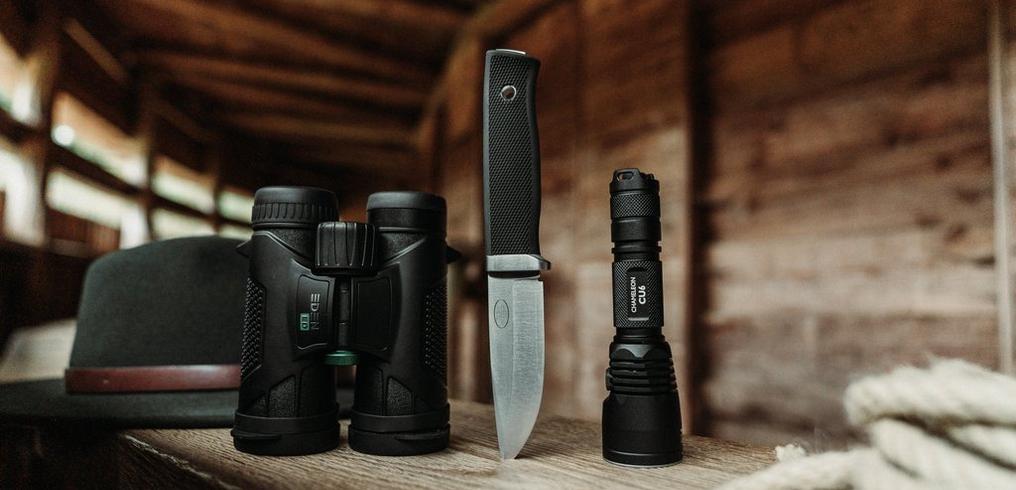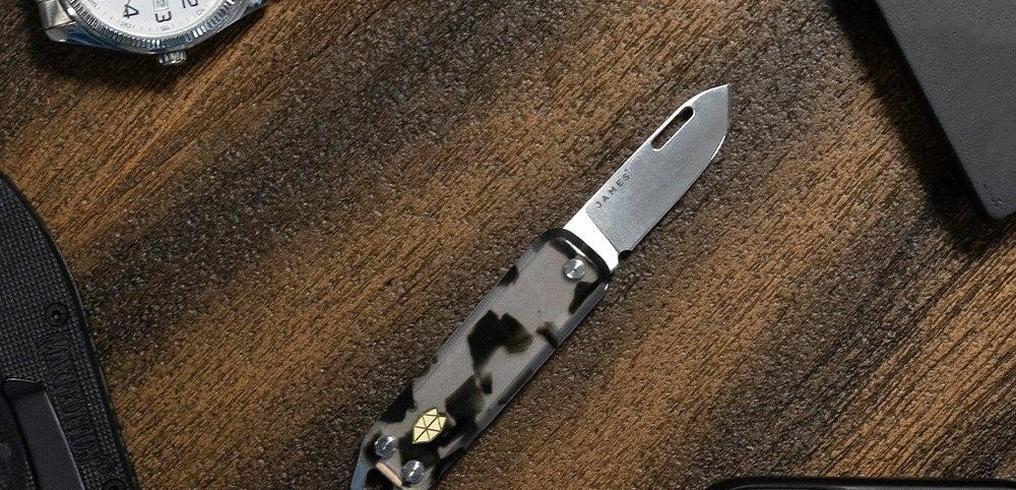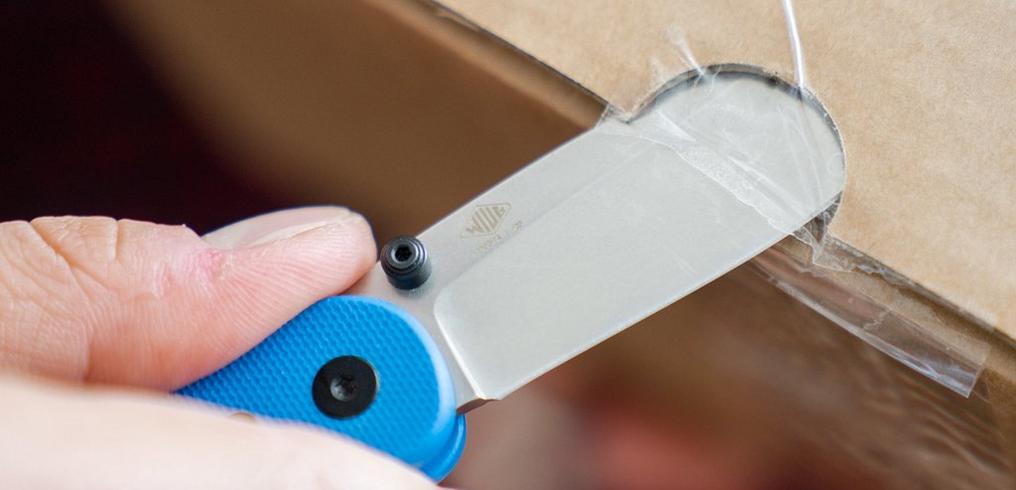Spotlight: Fällkniven F1 Pro outdoor knife
The Fällkniven F1 Pro is the improved version of the incredibly popular Fällkniven F1. Bushcraft fans and survival enthusiasts and hunters have embraced this knife and its predecessor. But what makes it so good? Knivesandtools explains!
History of the Fällkniven F1
To understand why the Fällkniven F1 Pro is such a good knife you need to know where it came from. So first, we will take a closer look at the history of the F1.
In the early nineties the Swedish air force was looking for a knife that would suit jet fighter pilots. Not that they could do much harm a couple thousand feet up in the air, but even jet fighter pilots could end up in survival situations. For that reason the Fällkniven F1 was 'recruited' in 1995 as the official survival knife for the Swedish pilots of the Saab JAS 39 Gripen fighter jet.
They carry the Fällkniven F1 in a simplified plastic sheath in a nylon bag that can be attached to the pilots' trousers on the outside of the thigh. As such they always have it close without it getting in the way in the cramped cockpit. The idea is that the pilot, after an emergency, can escape the cockpit by using the ejection seat and, after landing, can use the Fällkniven F1 to rescue themself.
What makes the Fällkniven knives so good?
Of course Fällkniven is not the only knife company on earth. Not even the only knife company in Sweden. So why would the Swedish air force select Fällkniven?
It is because Fällkniven closely looked at what you need when you are dropped in the wilderness in different climates. Jet fighters operate everywhere on earth, and not every knife will be equally suitable.
One of the important advantages of the Fällkniven F1 is, for instance, that the material used for the handle encloses the entire tang. That might sound like a small detail, but in very cold circumstances you don't want your hands to freeze on the handle because the tang is exposed at the top and bottom.
Convex grind
In addition, Fällkniven chose to enhance the blades with a convex grind. This means that the thinner part from the spine towards the edge isn't hollow but convex. This seems like a disadvantage, but it really isn't. After all, the knife doesn't have a secondary edge at the end of the blade. The grind is applied in one, convex line towards the edge. As such you don't have a 'shoulder' at the edge that leaves you with cutting resistance, and the edge itself is stronger.
A convex grind is difficult to produce in large numbers. For that reason you hardly ever come across it on production knives. And yet Fällkniven has successfully done so for over 20 years. Quite the achievement.
If you carry out more detailed work with a knife with a convex edge you will immediately notice the difference. Take, for instance, feather sticks. You will notice that you can cut the curls more evenly.
There are, of course, also 'downsides' to the convex grind. Some people find it a lot harder to sharpen. After all, you sharpen a 'convex' edge, and not a flat v-edge. The solution is stropping. In doing so you keep the convex grind sharp, without having to sharpen it too often. If the knife has become dull, you can use sharpening stones to sharpen a great convex grind, or you can use a sharpener such as the Work Sharp Ken Onion edition, which naturally leaves you with a convex edge.
Where are Fällkniven knives made?
In contrast to what people might think, Fällkniven knives are made in Japan. For years Fällkniven has been doing business there with the best knife makers the city has ever known. The fixed knives are produced by Hattori. Here, they apply the convex grinds by hand. The folding knives are made by Moki, a very prominent party when it comes to stunning gentleman's knives.
Difference Fällkniven F1 and F1 Pro
For years the conventional Fällkniven F1 was the standard. And today it is still one of the best and most popular outdoor knives on the market. Fällkniven, however, decided in 2015/2016, twenty years after the original release of the F1, that it was time to produce a modified version of the F1: the Pro collection.
The most important differences between the two are the type of steel, the guard, the size of the handle and the scope of delivery.
CoS vs VG10
One of the main differences is the type of steel. The F1 is made from laminated CoS steel, and the F1 Pro is made from laminated Elmax steel. Let's start with lamination: this means that there is a core of good and hard knife steel, laminated in between two layers of softer stainless steel. As such the blade is stronger and tougher, while the edge is still very hard.
Originally, the F1 was made from VG10 steel and the F1 Pro was made from CoS steel. VG10 is stainless and easy to sharpen. It retains its sharpness well and can definitely handle its own. A great type of steel for an all-round outdoor knife. But Fällkniven felt they could do better.
For that reason they started testing CoS-cobalt steel for a couple of years. Still stainless and relatively easy to sharpen, but CoS will retain its sharpness even longer and can definitely handle its own. On a chemical level VG10 and CoS are not that different. However, we suspect that CoS has a finer grain structure. Just like the difference between a 'normal' type of steel and a powdered type of steel. As such it will retain its sharpness longer and can handle a lot more.
Meanwhile, Fällkniven has continued using CoS steel in the production of the F1 and the steel of the F1 Pro has been upgraded to Elmax steel. Böhler Elmax is a fine and tough steel from Austria. Elmax stays sharp for a really long time but is also easy to sharpen yourself. Elmax is also very corrosion resistant.
Not only the type of steel is different about the F1 Pro. The thickness of the blade and the included grind are also different. The Fällkniven F1 has a 4.3 mm thick blade. The F1 Pro has a 4.9 mm thick blade. As such it feels a little more robust. Because of the lower grind the knife also has more 'spine' left to absorb the heavy loads. The F1 Pro is better suited to handle more serious cutting work.
When you see a thicker blade you also expect a thicker tip. To solve this Fällkniven enhanced the blade of the F1 Pro with a so-called swedge. This is a subtle bevel at the top of the blade at the tip. The tip of the F1 Pro is a little slimmer than the one on the F1.
Steel knife guard
The regular Fällkniven F1 only has a subtle protrusion at the front of the handle to protect your fingers. With the F1 Pro you immediately notice the large steel guard. This guard has multiple purposes.
It not only protects your fingers, it also protects the handle. The steel guard is properly secured on the blade. While batoning it could occur that the handle touches the wood. The thermorun on the handle may give way, but wear is inevitable in the long run. The steel guard solves this problem. It can definitely handle a lot and it makes sure that the relatively soft thermorun handle won't suffer.
A small footnote with the steel guard is that in the first batch of Pro knives that was produced there were a couple of models that had a problem with a guard that wasn't properly attached. Fällkniven immediately addressed this and ever since 2016 there are no longer knives with loose guards. Reviews that date back to that time do, however, still show this.
The thickness of the handle and the tang
One of the things that is often criticized on the Fällkniven F1 is that the handle feels a little too small for big hands. Fällkniven immediately thought of exactly that as they designed the F1 Pro. The handle is bigger to make sure it will properly fit larger hands. Internally something also changed here: the tang of the blade is already thicker because of the thicker blade, but the size of the tang is also larger. So, in terms of reliability, the F1 Pro also has its advantages here.
At the same time there are people who are not too happy with all extra features. They are not looking for a case with a sharpening stone, and will also be happy with a shorter warranty period. The result was the Fällkniven F1Pro10. This knife comes with a zytel sheath and is delivered in a simple box, with a 10-year warranty. Saves a lot of money, while the knife and sheath remained the same.
Conclusion
The Fällkniven F1 Pro is one of the most popular bushcraft knives on the market today. And rightly so! Because of the perfect use of materials, it is also one of the most durable knives. If you are looking for a comfortable and durable bushcraft knife which will feel at home anywhere in the world you cannot go wrong with the Fällkniven F1 Pro. Granted: it isn't the cheapest bushcraft knife on the market. However, you will rarely come across a bushcraft knife that is so suitable for all-round use, sturdy and comfortable to use.
?%24center=center&%24poi=poi&%24product-image%24=&fmt=auto&poi=%7B%24this.metadata.pointOfInterest.x%7D%2C%7B%24this.metadata.pointOfInterest.y%7D%2C%7B%24this.metadata.pointOfInterest.w%7D%2C%7B%24this.metadata.pointOfInterest.h%7D&scaleFit=%7B%28%24this.metadata.pointOfInterest%29%3F%24poi%3A%24center%7D&sm=c&w=762)
?%24center=center&%24poi=poi&%24product-image%24=&fmt=auto&poi=%7B%24this.metadata.pointOfInterest.x%7D%2C%7B%24this.metadata.pointOfInterest.y%7D%2C%7B%24this.metadata.pointOfInterest.w%7D%2C%7B%24this.metadata.pointOfInterest.h%7D&scaleFit=%7B%28%24this.metadata.pointOfInterest%29%3F%24poi%3A%24center%7D&sm=c&w=762)
?%24center=center&%24poi=poi&%24product-image%24=&fmt=auto&poi=%7B%24this.metadata.pointOfInterest.x%7D%2C%7B%24this.metadata.pointOfInterest.y%7D%2C%7B%24this.metadata.pointOfInterest.w%7D%2C%7B%24this.metadata.pointOfInterest.h%7D&scaleFit=%7B%28%24this.metadata.pointOfInterest%29%3F%24poi%3A%24center%7D&sm=c&w=762)
?%24center=center&%24poi=poi&%24product-image%24=&fmt=auto&poi=%7B%24this.metadata.pointOfInterest.x%7D%2C%7B%24this.metadata.pointOfInterest.y%7D%2C%7B%24this.metadata.pointOfInterest.w%7D%2C%7B%24this.metadata.pointOfInterest.h%7D&scaleFit=%7B%28%24this.metadata.pointOfInterest%29%3F%24poi%3A%24center%7D&sm=c&w=762)
?%24center=center&%24poi=poi&%24product-image%24=&fmt=auto&poi=%7B%24this.metadata.pointOfInterest.x%7D%2C%7B%24this.metadata.pointOfInterest.y%7D%2C%7B%24this.metadata.pointOfInterest.w%7D%2C%7B%24this.metadata.pointOfInterest.h%7D&scaleFit=%7B%28%24this.metadata.pointOfInterest%29%3F%24poi%3A%24center%7D&sm=c&w=762)



?%24center=center&%24poi=poi&%24product-image%24=&fmt=auto&h=490&poi=%7B%24this.metadata.pointOfInterest.x%7D%2C%7B%24this.metadata.pointOfInterest.y%7D%2C%7B%24this.metadata.pointOfInterest.w%7D%2C%7B%24this.metadata.pointOfInterest.h%7D&scaleFit=%7B%28%24this.metadata.pointOfInterest%29%3F%24poi%3A%24center%7D&sm=c&w=1016)

?%24center=center&%24poi=poi&%24product-image%24=&fmt=auto&h=490&poi=%7B%24this.metadata.pointOfInterest.x%7D%2C%7B%24this.metadata.pointOfInterest.y%7D%2C%7B%24this.metadata.pointOfInterest.w%7D%2C%7B%24this.metadata.pointOfInterest.h%7D&scaleFit=%7B%28%24this.metadata.pointOfInterest%29%3F%24poi%3A%24center%7D&sm=c&w=1016)


